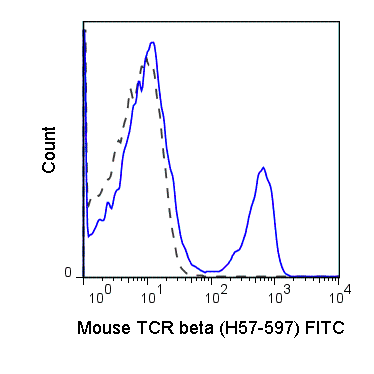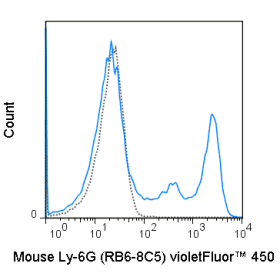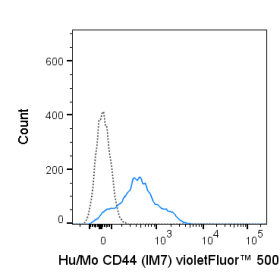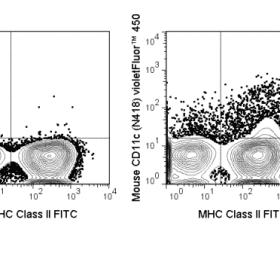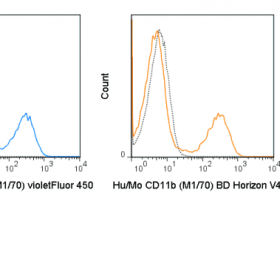The H57-597 antibody is specific for the beta chain of the mouse T cell Receptor (TCR). This cell surface protein combines with a second protein chain (alpha chain) to form the alpha-beta TCR that is expressed by NK1.1+ thymocytes, NKT cells, and the majority of peripheral T cells. A small number of T cells may express an alternative heteromer of gamma/delta protein chains, known as the g/d TCR. These receptors participate in a complex with CD3, and with the co-receptors CD4 or CD8, to recognize and respond to antigens bound to MHC molecules on antigen-presenting cells. Such interactions promote T cell receptor signaling (T cell activation) and can result in a number of cellular responses including proliferation, differentiation, production of cytokines or activation-induced cell death.
The H57-597 antibody is used as a phenotypic marker for T cells expressing the alpha-beta TCR. It is also widely used to cross-link surface TCR and thereby mimic TCR-mediated cell activation or induction of apoptosis. The antibody does not cross-react with cells expressing the g/d TCR.
Recent Publications:
Finkin S, Yuan D, Stein I, Taniguchi K, Weber A, Unger K, Browning JL, Goossens N, Nakagawa S, Gunasekara G, Schwartz ME et al. 2015. Nat Immunol. doi: 10.1038/ni.3290. (Flow Cytometry)
Product Details
| Name | FITC Anti-Mouse TCR beta (H57-597) |
|---|---|
| Cat. No. | 35-5961 |
| Alternative Names | TCRb, TCRbeta, TCR-b chain, TCR-b, b-TCR |
| Gene ID | 21577 |
| Clone | H57-597 |
| Isotype | Armenian Hamster IgG |
| Reactivity | Mouse |
| Cross Reactivity | |
| Format | FITC |
| Application | Flow Cytometry |
| Citations* | Dolina JS, Lee J, Griswold RQ, Labarta-Bajo L, Kannan S, Greenbaum JA, Bahia El Idrissi N, Pont MJ, Croft M, Schoenberger SP. TLR9 Sensing of Self-DNA Controls Cell-Mediated Immunity to Listeria Infection via Rapid Conversion of Conventional CD4+ T Cells to Treg. Cell Rep. 2020 Apr 7;31(1):107249. doi: 10.1016/j.celrep.2020.01.040.
Berent-Maoz B, Montecino-Rodriguez E, Signer RAJ, and Dorshkind K. 2012. Blood. 199:5715-5721. (Flow cytometry) Wang D, Qin H, Du W, Shen Y-W, Lee W-H, Riggs AD, and Liu C-P. 2012. Proc. Natl. Acad. Sci. 109:9493-9498. (in vitro induction of apoptosis) O’Brian RL, Taylor MA, Hartley J, Nuhsbaum T, Dugan S, Lahmers K, Aydintug MK, Wands JM, Roark CL, and Born WK. 2009. Invest. Ophthalmol. Vis. Sci. 50: 3266-3274. (Immunofluorescence microscopy – OCT embedded frozen tissue) Matei IR, Gladdy RA, Nutter LMJ, Canty A, Guidos CJ, and Danska JS. 2007. Blood. 109:1887-1896. (Immunoprecipitation) Harada N, Shimada M, Okano S, Suehiro T, Soejima Y, Tomita Y, and Maehara Y. 2004. J. Immunol. 173:6635-6644. (in vivo T cell depletion) Kubo RT, Born W, Kappler JW, Marrack P, and Pigeon M. 1989. J. Immunol. 142: 2736-2742. (Origination of clone, Immunoprecipitation, in vitro activation) |
Application Key:FC = Flow Cytometry; FA = Functional Assays; ELISA = Enzyme-Linked Immunosorbent Assay; ICC = Immunocytochemistry; IF = Immunofluorescence Microscopy; IHC = Immunohistochemistry; IHC-F = Immunohistochemistry, Frozen Tissue; IHC-P = Immunohistochemistry, Paraffin-Embedded Tissue; IP = Immunoprecipitation; WB = Western Blot; EM = Electron Microscopy
*Tonbo Biosciences tests all antibodies by flow cytometry. Citations are provided as a resource for additional applications that have not been validated by Tonbo Biosciences. Please choose the appropriate format for each application and consult the Materials and Methods section for additional details about the use of any product in these publications.




